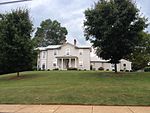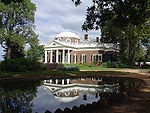Monticello ( MON-tih-CHEL-oh) was the primary plantation of Thomas Jefferson, a Founding Father and the third president of the United States, who began designing Monticello after inheriting land from his father at age 14. Located just outside Charlottesville, Virginia, in the Piedmont region, the plantation was originally 5,000 acres (20 km2), with Jefferson using the labor of African slaves for extensive cultivation of tobacco and mixed crops, later shifting from tobacco cultivation to wheat in response to changing markets. Due to its architectural and historic significance, the property has been designated a National Historic Landmark. In 1987, Monticello and the nearby University of Virginia, also designed by Jefferson, were together designated a UNESCO World Heritage Site. The current nickel, a United States coin, features a depiction of Monticello on its reverse side.
Jefferson designed the main house using neoclassical design principles described by Italian Renaissance architect Andrea Palladio and reworking the design through much of his presidency to include design elements popular in late 18th-century Europe and integrating numerous ideas of his own. Situated on the summit of an 850 ft-high (260 m) peak in the Southwest Mountains south of the Rivanna Gap, the name Monticello derives from Italian meaning "little mountain". Along a prominent lane adjacent to the house, Mulberry Row, the plantation came to include numerous outbuildings for specialized functions, e.g., a nailery; quarters for slaves who worked in the home; gardens for flowers, produce, and Jefferson's experiments in plant breeding—along with tobacco fields and mixed crops. Cabins for slaves who worked in the fields were farther from the mansion.At Jefferson's direction, he was buried on the grounds, in an area now designated as the Monticello Cemetery. The cemetery is owned by the Monticello Association, a society of his descendants through Martha Wayles Skelton Jefferson. After Jefferson's death, his daughter Martha Jefferson Randolph, apart from the small family graveyard, sold Monticello for $7,500. In 1834, it was bought by Uriah P. Levy, a commodore in the U.S. Navy, for $2,500, (~$78,667 in 2022) who admired Jefferson and spent his own money to preserve the property. His nephew Jefferson Monroe Levy took over the property in 1879; he also invested considerable money to restore and preserve it. In 1923, Monroe Levy sold it for $500,000 (~$6.72 million in 2022) to the Thomas Jefferson Foundation (TJF), which operates it as a house museum and educational institution.










